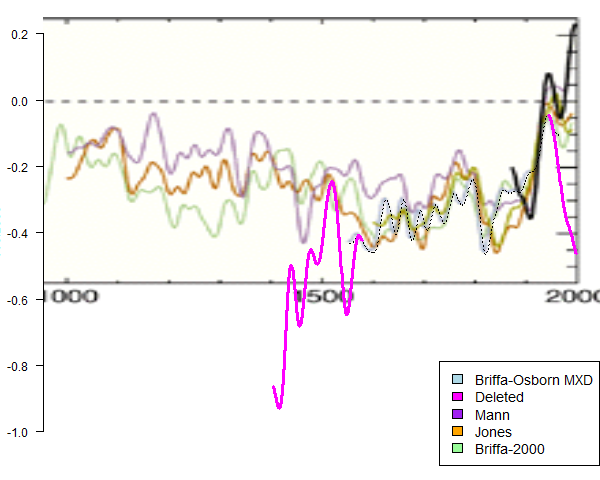NOTE: since this is clearly an important finding with far reaching implications, this will be a “top post” at WUWT for the next couple of days. I urge other bloggers to spread the word. – Anthony
Just when you think the bottom of the Hockey Stick rabbit hole has been reached, Steve McIntyre finds yet more evidence of misconduct by the Team.
The research was from Briffa and Osborn (1999) published in Science magazine and purported to show the consistency of the reconstruction of past climate using tree rings with other reconstructions including the Mann Hockey Stick. But the trick was exposed in the Climategate dossier, which also included code segments and datasets.
In the next picture, Steve shows what Briffa and Osborn did – not only did they truncate their reconstruction to hide a steep decline in the late 20th Century but also a substantial early segment from 1402-1550:

As I’ve written elsewhere, this sort of truncation can be characterized as research misconduct – specifically falsification. But where are the academic cops? Any comment from Science magazine?
Steve also discusses the code underlying the plot and you can see how the truncation is a clear deliberate choice – not something that falls out of poorly understood analysis or poor programming.
In the comments, Kip Hansen posts the following:
In reference to Mann’s Trick….obliquely, yesterday’s Supreme Court ruling on Zicam (a homeopathic nasal spray) ruled in part:
http://www.nytimes.com/2011/03/23/health/23bizcourt.html?_r=1&hpw
The Supreme Court has said that companies may be sued under the securities law for making statements that omit material information, and it has defined material information as the sort of thing that reasonable investors would believe significantly alters the ‘total mix’ of available information.
Justice Sonia Sotomayor, writing for the court on Tuesday, roundly rejected Matrixx’s proposal that information can be material only if it meets standards of statistical significance.
‘Given that medical professionals and regulators act on the basis of evidence of causation that is not statistically significant,’ she wrote, ‘it stands to reason that in certain cases reasonable investors would as well.’
Thus, hiding or omitting information, even if one feels it is ‘erroneous’ or ‘outlying’ (or whatever they claim) is still possibly fraudulent ( or in this case, scientifically improper) if it would ‘add to the total mix of available information’. Statistical significance is not to be the deciding factor.
In the case of Briffa and Osborn, no statistical fig leaf was applied that justified the truncation of data, so far as I can see.